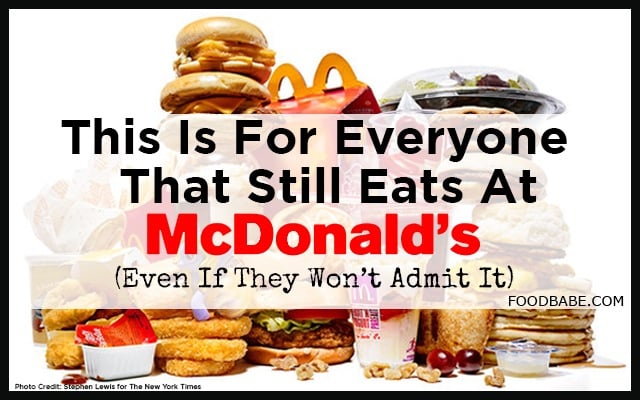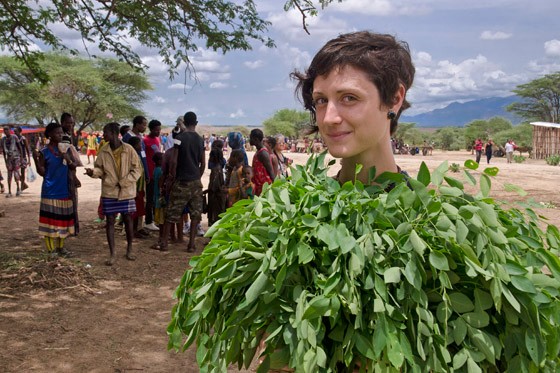By Food Babe
Someone recently asked me what I think the worst ingredients are at McDonald’s and my first thought was… “Um, where do I start?!” The 37-page ingredient list for McDonald’s reads like an encyclopedia of nutrition-less, additive-filled, processed food. It should be pretty obvious that I don’t eat at McDonald’s (and many of you may not either) but I still have family members and friends that eat there on a regular basis (and I can guess you probably do too!).
According to a recent Morgan Stanley report, young adults eat at McDonald’s more than any other restaurant. What I found funny about their report is that while they eat there, they won’t admit it to their friends because they consider the food there so low quality.
Although most of us realize their food isn’t healthy and McDonald’s reports that their sales are struggling – they continue to feed thousands of Americans, day in and day out and that’s why it’s so important for you to share this information with all your friends and family members.

Do the people that eat at McDonald’s realize how many questionable chemicals they are eating in one meal?
McDonald’s announced recently that they are going through some major menu changes, and will be nixing some unnecessary ingredients. They also are finally listening to us, and will stop using chickens that are injected with growth-promoting antibiotics, along with dairy products raised with the growth hormone rbST but they still are using a lot of factory farmed meat and the beef is still raised with antibiotics.
McDonald’s even said they might add kale to their menu, by putting it in salads or in a smoothie. I LOVE kale, and I hope they don’t find a way to ruin it. You know the saying, “You can put lipstick on a pig, but it’s still a pig”. So, they need to do a lot more than just add kale to their menu before I’d ever eat there. The problem is that millions are still eating there and consuming several questionable food additives that McDonald’s could remove entirely if they really wanted to.
I know this because McDonald’s is already doing it for our friends overseas.
If you compare their ingredients with what they serve in London, you’ll see that many of the food additives used in the U.S. aren’t used over there at all, such as TBHQ, BHA, propyl gallate, azodicarbonamide, sodium phosphate and artificial colors. Instead of frying their food in partially hydrogenated oils laced with dimethylpolysiloxane like they do in the U.S., they use a non-hydrogenated vegetable oil blend instead. They also serve organic milk and don’t use GMO ingredients overseas – all while serving us GMOs here in the States. What they’re serving in other countries isn’t perfect, but it’s better.
When you eat just ONE single menu item at McDonald’s, even a “healthy” item like their Premium Southwest Grilled Chicken Salad, you’re really eating ingredients like powdered cellulose, soybean oil, autolyzed yeast extract, and high fructose corn syrup – and that doesn’t even include the dressing that’s loaded with more soybean oil and refined sugars. It’s no wonder that America is struggling as a nation with obesity, diabetes and heart disease. What would happen if McDonald’s took the lead here and finally ditched the worst ingredients on their menu? How much would the health of our nation improve?
My “Hit List” of the WORST 12 ingredients at McDonald’s No One Should Be Eating (8 of them aren’t even used in the UK at all)!
I compiled a little hit list of the biggest offenders on McDonald’s menu. If they got rid of these ingredients, dozens of menu items would be transformed for the better. Inform your friends!

1. Partially Hydrogenated Oils (19 menu items): These oils have no place in our food, as the main source of trans fats in our diet that has been unequivocally linked to heart disease and death. Until the FDA finally bans it, this ingredient should be voluntarily removed. Why should they wait for the FDA to force them to take it out when they already don’t use it in other countries? McDonald’s uses partially hydrogenated oil in their “liquid margarine” that’s used to cook their eggs – and even their “egg whites” that are advertised as a healthier option. You’ll find it in virtually all of their breakfast items with either an egg or biscuit, like Egg McMuffins, Bacon, Egg & Cheese Bagel, and even in their low-calorie “Egg White Delight”.
2. Artificial Colors or Caramel Color (31 menu items): Artificial colors are an easy ingredient to ditch, since they don’t serve a purpose other than making “food” look better. These ingredients are on EWG’s Dirty Dozen Food Additives list, because caramel coloring is associated with cancer and there’s ongoing debate about the effects of artificial colors on children’s behavior. I’m a sucker for good ice cream, but McDonald’s doesn’t have it. McDonald’s chocolate, vanilla, and strawberry shakes are all artificially colored with either Red 40 or Yellow 5. Their “McCafe” mochas and chocolate chip frappes are tainted with artificial color Red 40 and caramel coloring. They also add caramel color to their “healthy” items like oatmeal and 8-Grain English Muffin (that’s used in the Egg White Delight), probably to make them look darker and more healthful.
3. Azodicarbonamide (aka The Yoga Mat Chemical) (30 menu items): This ingredient has been dropping like flies ever since I petitioned Subway to remove it from their bread. Pizza Hut, Bimbo Bakeries, Martin’s Potato Bread, Nature’s Own, Olive Garden, Starbucks, and Publix Grocery Store have announced they also have plans to remove the chemical from their products – and I think McDonald’s should be next. The EWG supported my petition because, “It is an industrial chemical added to bread for the convenience of industrial bakers,” and “EWG recommends that consumers take steps to avoid the industrial additive ADA in their food. It is an unnecessary ingredient, its use has raised concerns about occupational exposure, and questions remain about its potential risk to consumers. EWG also calls on all manufacturers to immediately end its use in food”. Nearly every sandwich at McDonald’s is still made with a bun that contains azodicarbonamide, from their most basic hamburger to the classic Big Mac.
4. Carrageenan (44 menu items): The Cornucopia Institute, has completed an in-depth analysis regarding the safety of this ingredient and subsequently petitioned the FDA to remove carrageenan from the “Generally Regarded As Safe” or GRAS determination. According to Cornucopia, animal studies show that “food-grade carrageenan causes gastrointestinal inflammation and higher rates of intestinal lesions, ulcerations, and even malignant tumors”. McDonald’s adds carrageenan to “crispy chicken” items like the Crispy Chicken Classic Sandwich and the Crispy Chipotle BBQ Snack Wrap. You’ll also find carrageenan in their vanilla ice cream, McFlurries, Shakes, and in some breakfast sandwiches like the Sausage, Egg & Cheese McGriddles.
5. High Fructose Corn Syrup (30 menu items): This type of sweetener has been shown to contribute more to obesity and diabetes than regular cane sugar (sucrose). Even if you don’t drink a Coke at McDonald’s, you’ll likely eat something with High Fructose Corn Syrup. It’s in most of the sauces that are slathered on their burgers, the Southwest Chicken wrap, and it’s mixed into their shakes and frappes. Not included in my count, but it’s also found in some of the dipping sauces that come with Chicken McNuggets such as the Sweet n’ Sour, BBQ, and ketchup.
6. Soybean Oil (65 menu items): Soybean oil is processed to death (usually with toxic hexane) and is very high in omega-6 fatty acids that are associated with an increased the risk of inflammation, cardiovascular disease, cancer, and autoimmune diseases. I was downright shocked at the number of items that contain soybean oil at McDonald’s, and it would be a shorter list if I just summarized where you won’t find it! That’s because soybean oil is used in their fried items, buns, eggs, tortillas, and sauces – it’s pretty much impossible to avoid at McDonald’s.
7. TBHQ & Dimethylpolysiloxane (27 menu items): They use both of these ingredients in the oil in their fryers – but only in North America! TBHQ is a synthetic preservative that McDonald’s competitor Chick-fil-A is finally dumping, as it’s truly unnecessary. TBHQ is derived from petroleum and eating only 1 gram has been shown to cause all sorts of issues, from asthma to allergies, dermatitis, dizziness and it has even been linked to cancer. Dimethylpolysiloxane, the “silly putty” ingredient, simply doesn’t belong in food, and McDonald’s doesn’t use it in their fryers in other countries. So, why use it here? You’ve probably heard about its use in McDonald’s french fries and McNuggets, but you may not realize that it’s in other fried items like the Filet-O-Fish, Crispy Chicken Salads and Crispy Chicken McWraps.
8. BHA & Propyl Gallate (10 menu items): You’re not starting your day off right with these risky preservatives found in many breakfast items at McDonald’s. These preservatives are used together by McDonald’s and are both on the EWG’s Dirty Dozen List of Food Additives to avoid. BHA has been shown to be an endocrine disruptor and is believed to be a carcinogen, as BHA has caused tumors in animal studies. Propyl gallate has also been associated with tumors and endocrine disruption. You’ll find both of these ingredients in their Sausage Egg McMuffins, Sausage McGriddles, and Big Breakfasts.
9. Hidden MSG, Yeast Extract, Hydrolyzed Protein (23 menu items): Instead of adding straight-up monosodium glutamate (MSG) to their food, they sneak in other additives (yeast extract and hydrolyzed proteins) that contain free glutamic acid, the main component of MSG. These ingredients are purely used to make you crave their food and eat more than you should, and are excitotoxins that are associated with neurodegenerative diseases. McDonald’s adds these to Chicken McNuggets and Chicken Selects chicken strips, along with some burger sauces like the Big Mac sauce and Buttermilk Ranch sauce. You’ll even find it in salads with crispy chicken.
10. Sodium Phosphate (56 menu items): This preservative is so commonly used that if you eat processed food, you likely eat it daily. That doesn’t mean it’s safe. When you eat phosphate additives often, it can lead to excessive levels of phosphate in the blood and puts you at risk of chronic kidney disease, increased mortality, heart disease, and accelerated aging. The EWG also warns that sodium phosphate is an additive to avoid. This preservative is used in all of their cheese slices and in their ice cream, so all burgers with cheese and shakes contain it. It also preserves the crispy chicken used in McWraps and salads.
11. Cellulose (30 menu items): Ground breaking research links this additive to weight gain, inflammation and digestive problems. As reported by CBS News, “A new study, published Wednesday in the journal Nature, finds evidence that these chemicals in food can alter the gut bacteria, or microbiome, potentially causing intestinal inflammation which makes a person more likely to develop inflammatory bowel disease, metabolic syndrome and significant weight gain”. McDonald’s adds cellulose to the shredded cheese in their McWraps, their Sausage Breakfast Burrito, biscuits, shakes, smoothies and ice cream.
12: DATEM (30 menu items): The acronym “DATEM” stands for “Diacetyl Tartaric Acid Esters of Monoglycerides”, and it’s a dough conditioner that is usually derived from soybean or canola oil (GMO crops). This ingredient can be a hidden form of deadly trans fat in our food that most people don’t know about. Just like partially hydrogenated oils, these artificial trans fats have been linked to heart disease and the CDC attributes them to up to “7,000 coronary heart disease deaths each year in the U.S”! This chemical invention is clearly not a necessary ingredient in bread, but you’ll find it in most of McDonald’s buns and in their english muffins.
If you’re like me and still have loved ones eating at McDonald’s, please share this post with them!
The more awareness we can bring to these chemicals that are being served up to thousands of Americans everyday as “food”, the faster these companies will change! I have something new and really exciting coming out next week that can transform your lunchtime eating habits. Make sure you’re subscribed to email updates so that you don’t miss out!
http://foodbabe.com/2015/03/27/everyone-still-eats-mcdonalds-even-wont-admit/
Click Here For More Articles
 I continued to work out. I’ve always loved comic books, Wolverine, Arnold Schwarzenegger, and that super-fit physique.
I continued to work out. I’ve always loved comic books, Wolverine, Arnold Schwarzenegger, and that super-fit physique. I continued to work out. I’ve always loved comic books, Wolverine, Arnold Schwarzenegger, and that super-fit physique.
I continued to work out. I’ve always loved comic books, Wolverine, Arnold Schwarzenegger, and that super-fit physique.





















